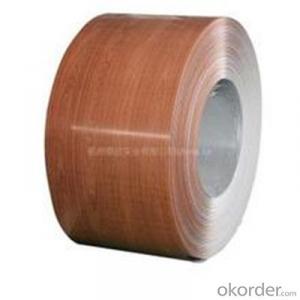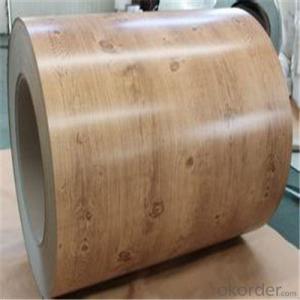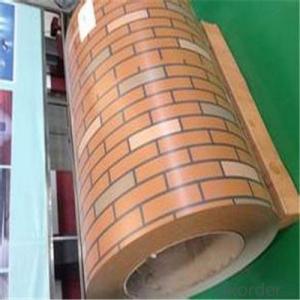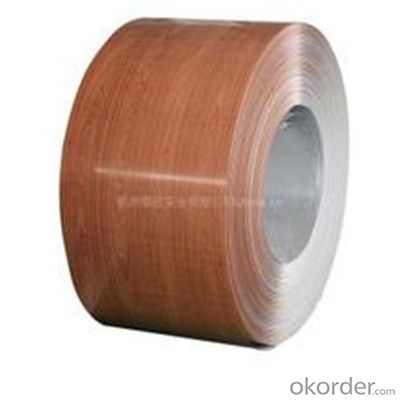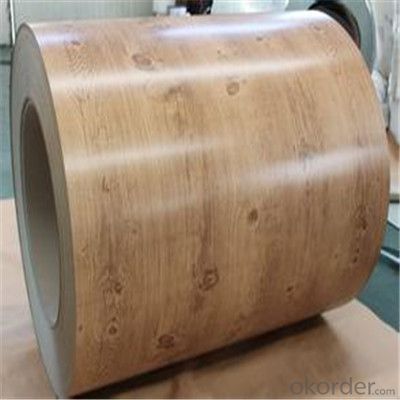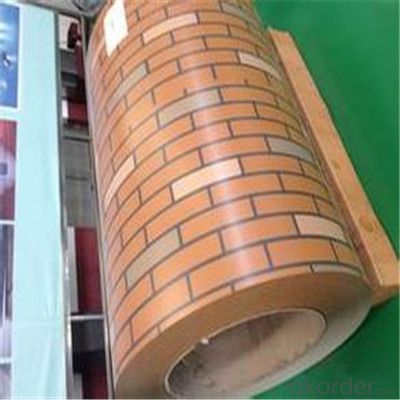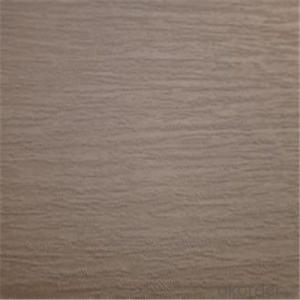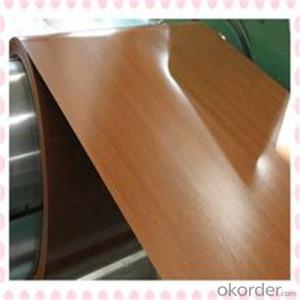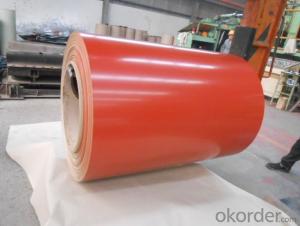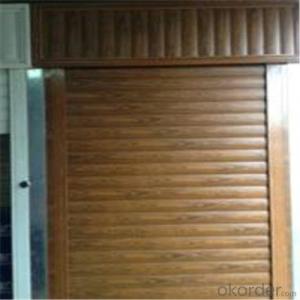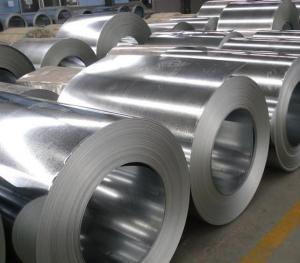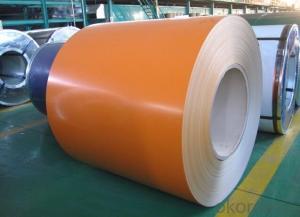Wood Grain Coated Galvanized PPGI Steel Plates
- Loading Port:
- Shanghai
- Payment Terms:
- TT OR LC
- Min Order Qty:
- 66 m.t.
- Supply Capability:
- 1200000 m.t./month
OKorder Service Pledge
OKorder Financial Service
You Might Also Like
Specification
Description of Glove:
1. Environment friendly
2. Lower cost and maintenance
3. Long using time up to 10 years
4. Fast construction, time saving and labor saving
5. Easy cleaning
6. Antistatic
Festures of Glove:
1. Width: 600~1250mm
2. Thickness: 0.19~1.50mm
3. Grade: JIS G3312-CGCC, CGC340-570, (G550) ASTM A755M CS-B, SS255-SS550
4. Coil Weight: 3~10MT
5. Coil ID: 508mm/610mm
6. Chemical Treatment: Chromated (Cr 3+, 6+, 0+)
7. Surface: Skin pass/Non Skin Pass
8. Oil: Slight Oiled/Dry
9. Zinc Coating: Z40~Z275gr/m2 (both side total coating thickness)
10.Package:Standard export seaworthy package
Specifications of Glove:
1) Steel buildings and constructions: roofing, ceilings, gutters, venting lines, indoor decorations, doors,window frames etc.
2) Electrical appliances: computer shells, washing machines, refrigerators, dehumidifiers, video recorders, water heaters etc.
3) Agricultural equipments: troughs, feeding tools, agricultural driers, irrigation channels etc.
4) Vehicle parts: back-seat plates of buses and trucks, conveying systems, oil tanks etc.
Images of Glove:
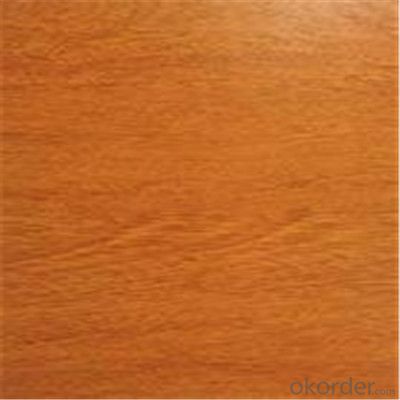
FAQ:
1.What about the delivery.
We can arrange the shipment about 15-25 days after the deposit.
2.What about payment term?
30% T/T deposit, balance against B/L copy.
Full T/T payment if quantity less than MOQ.
3.How much about MOQ?
Normally 100pcs,but small order is acceptable as well.
- Q: How are steel coils used in the manufacturing of engine mounts?
- Steel coils are used in the manufacturing of engine mounts to provide structural support and absorb vibrations generated by the engine. The coils are designed to provide tension and flexibility, allowing the engine to be securely mounted while minimizing the transmission of vibrations to the rest of the vehicle.
- Q: How are steel coils used in the manufacturing of lighting fixtures?
- Steel coils are used in the manufacturing of lighting fixtures primarily for their structural strength and durability. The steel coils are shaped and formed into various components such as brackets, frames, and housings that provide stability and support for the lighting fixtures. Additionally, the steel coils are often coated or plated to enhance their aesthetic appeal and protect against corrosion.
- Q: How do steel coils contribute to the construction sector?
- Steel coils contribute to the construction sector in several ways. Firstly, they are used to manufacture structural components such as beams, columns, and steel frames, which provide strength and support to buildings and infrastructure. Secondly, steel coils are used to produce reinforcement bars that are embedded in concrete, enhancing its tensile strength and durability. Additionally, steel coils are utilized in the construction of bridges, pipelines, and other large-scale projects that require robust and long-lasting materials. Overall, steel coils play a vital role in the construction sector by providing the necessary materials for sturdy and resilient structures.
- Q: What are the different methods of uncoiling steel coils?
- There are several methods used for uncoiling steel coils, including hydraulic uncoiling, motorized uncoiling, and manual uncoiling. Hydraulic uncoiling involves using hydraulic cylinders to unwind and release the tension in the coil. Motorized uncoiling utilizes a motorized mandrel or decoiler to unwind the coil. Manual uncoiling, on the other hand, requires physical effort to unwind the coil by hand. Each method has its own advantages and is chosen based on the specific requirements and capabilities of the uncoiling process.
- Q: I wanna strip down my bike and take off all the paint... im thinking of leaving it just the steal color... Do i need to put anythinng on the steel to coat it or can i just leave it like that... Will it rust or anything?
- There is another thing you can do to inhibit corrosion on bare metal surfaces. Use a good quality automotive wax. Apply it with diligence, and keep the bike in the garage when you're not using it so it stays dry. Touch up the wax job every now and then to maintain the protective finnish.
- Q: i have a computer chair where the metal part that attachs the top part to the bottom with wheels has cracked around half of the assembly. my dad said it might be able to be repaired with jb weld. can jb weld fix it? how strong is jb weld? is it as strong as steel?
- ...
- Q: I have two theories, which one's correct?My book says that steel is made up of 98% iron and 2% carbon.98% of iron's molar mass (55.85 g/mol) is 54.733.2% of carbon's molar mass (12.01 g/mol) is .2402.If you add them up that gives you that steel has a molar mass of 54.97 g/mol.However, steel's chemical formula is Fe(3)CThat would make it's molar mass 179.56 g/mol.( Because 3(55.85) + 12.01 = 179.56 )Which one is correct?
- Steel is an alloy - a mixture not a compound; it doesn't have a chemical formula. Only elements and compounds have molecular weights, not mixtures that aren't composed of a uniform molecule, so neither answer is correct.
- Q: How do steel coil manufacturers meet customer specifications?
- Steel coil manufacturers meet customer specifications by following a comprehensive and systematic approach that involves various stages and processes. Here are some key steps they take: 1. Understanding customer requirements: Manufacturers initiate the process by thoroughly understanding the specific requirements of their customers. This includes determining the desired dimensions, tolerances, mechanical properties, surface finish, and any other specific characteristics needed. 2. Material selection: Based on the customer's requirements, manufacturers select the appropriate type and grade of steel to meet their specifications. This involves considering factors such as strength, corrosion resistance, formability, and cost-effectiveness. 3. Production planning: Manufacturers carefully plan their production processes to ensure that customer specifications are met. This involves determining the appropriate manufacturing techniques, equipment, and resources required. 4. Coil processing: Steel coils are processed through various stages such as hot rolling, cold rolling, annealing, pickling, and coating, depending on the customer's specifications. Each step is carefully controlled to achieve the desired properties and dimensions. 5. Quality control: Throughout the manufacturing process, strict quality control measures are implemented to ensure that the coils meet the customer's specifications. This includes regular inspections, testing, and compliance with industry standards. 6. Customization and flexibility: Steel coil manufacturers often offer customization options to meet specific customer needs. They have the capability to adjust the thickness, width, and length of the coils to match the desired specifications. 7. Communication and collaboration: Effective communication and collaboration between the manufacturer and the customer are crucial to meeting specifications. Manufacturers work closely with their customers to address any concerns or modifications required during the manufacturing process. 8. Documentation and certification: Once the steel coils are manufactured, manufacturers provide detailed documentation and certifications to ensure traceability and compliance with customer specifications. This includes providing test reports, material certificates, and any other necessary documentation. By following these steps, steel coil manufacturers can consistently meet customer specifications, ensuring that the final product meets the desired requirements and quality standards.
- Q: What are the different types of steel coatings for coil protection?
- There are several types of steel coatings for coil protection, including galvanized coatings, zinc coatings, aluminum coatings, and polymer coatings.
- Q: I already have the county permits and bank loan, but the foundation hasn't been poured. Is it too late to convert to steel?
- Steel is going to be a whole different world. You will need to go back to square one and get house plans that are drawn for structural steel. First thing you need to do is find a builder that knows how to build with steel and get an idea of the price.
Send your message to us
Wood Grain Coated Galvanized PPGI Steel Plates
- Loading Port:
- Shanghai
- Payment Terms:
- TT OR LC
- Min Order Qty:
- 66 m.t.
- Supply Capability:
- 1200000 m.t./month
OKorder Service Pledge
OKorder Financial Service
Similar products
Hot products
Hot Searches
Related keywords
